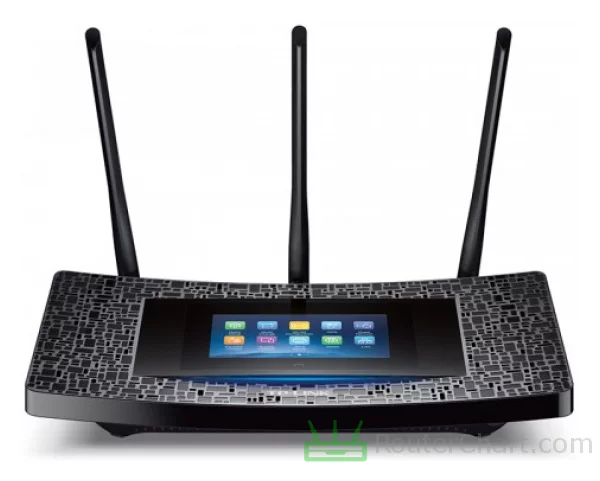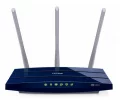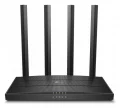TP-Link AC1900 Touch P5 router review
TP-Link introduced the AC1900 Touch P5 router in 2015. It is powered by Broadcom BCM4709 @ 1 GHz chipset, 128 MB of RAM, and 128 MB of flash memory.
Want to know if the AC1900 Touch P5 is a game-changer? Keep reading to find out!
Table of Contents
- TP-Link AC1900 Touch P5 specifications
- Body, dimensions, weight
- System, chipset, RAM, flash, power supply
- Network, protocols, WAN and LAN ports
- Wireless, antennas, speed, security
- Connectivity
- Features
- Administration, user interface, login information
- Links
- Verdict, Pros and Cons
- Photos
- Comparisons
Our personal experiences and opinions form the basis of this article. We aimed to share insights on a topic, and we hoped others would find it useful and inspirational. If you noticed any mistakes or missing details about the TP-Link AC1900 Touch P5, please let us know.

The AC1900 Touch P5 supports dual-band Wi-Fi, offering both 2.4 GHz and 5 GHz bands. TP-Link has received awards and recognition for its excellent networking products.
TP-Link AC1900 Touch P5 specifications
| Brand | TP-Link |
|---|---|
| Name | AC1900 Touch P5 |
| Type | TP5 |
| Rating | |
| Launch | 2015 |
Body
| Dimensions | 284 x 157 x 52 mm |
|---|
If you live in a small apartment, the size of the router is crucial to deciding whether it will fit.

System
| Chipset | Broadcom BCM4709 @ 1 GHz |
|---|---|
| RAM | 128 MB |
| Flash | 128 MB |
| OS | TP-Link |
| Power supply | 12 V / 3.3 A |
The Broadcom BCM4709 @ 1 GHz CPU affects the router's performance, working with RAM and firmware. You cannot expand the router's memory (128 MB). When selecting a router, it's essential to think about the RAM specifications.

Network
| Protocols | IPv4 IPv6 |
|---|---|
| LAN ports | 4 x 10/100/1000 Mbps |
| WAN ports | 1 x 10/100/1000 Mbps |
| Mobile network | no |
| VPN support | no |
The AC1900 Touch P5 router is compatible with IPv6. IPv6 offers many enhancements and improvements over IPv4. The router has Gigabit Ethernet ports. They allow for faster communication between devices on your local network. A Gigabit WAN port is useful when your internet plan supports high speeds.

Wireless
| Antennas | 3 x 5 dBi RP-SMA |
|---|---|
| 2.4 GHz | yes |
| 5 GHz | yes |
| 60 GHz | no |
| Standards | IEEE 802.11a/b/g/n/ac |
| Class | AC1900 |
| Speed | 600 + 1300 Mbps |
| Transmit power | 23 dBm |
| Security | WEP WPA WPA2 |
| Guest network | yes |
Many IoT devices, smart home devices, and older Wi-Fi devices mainly use the 2.4 GHz band. To optimize your Wi-Fi experience, it's often recommended to use a combination of both 2.4 GHz and 5 GHz bands. This AC Wi-Fi router supports multiple spatial streams, typically up to 4 streams. The introduction of WPA2 (Wi-Fi Protected Access 2) improved upon WEP. It provides stronger security.

Connectivity
| USB ports | 1 x USB 2.0 1 x USB 3.0 |
|---|---|
| Print server | yes |
| File server | yes |
The USB 2 port has a maximum theoretical data transfer rate of 480 megabits per second (Mbps). The USB 3 ports provide a fast interface for external storage with data transfer rates of up to 4.8 Gbps. A USB print server lets you connect a printer to your network. Then, computers can print to it without a direct connection. The AC1900 Touch P5 router lets you schedule backups. You can back up to the connected USB storage device.
Features
| Specials | Touchscreen |
|---|
Administration
| Default IP | 192.168.0.1 |
|---|---|
| Default username | admin |
| Default password | admin |
Changing the password often is a good security practice. It protects your network and devices from unauthorized access. Changing the default password improves your router's security. It reduces the risk of unauthorized individuals controlling your network.
Links
| Official site | https://www.tp-link.com/ |
|---|
Pros and Cons
Every router, including this TP-Link one, has its good sides and not-so-good sides. Let's take a closer look at both to get a full understanding of what this router can do. Just remember, this is just what I think, and you might see things differently.
Pros
- sufficient memory
- adequate flash
- IPv6 capable
- high-speed LAN port
- high-speed WAN port
- works on 5 GHz band
- decent Wi-Fi performance
- USB 2 compatible
- USB 3 compatible
- printserver functionality
- fileserver operation
Cons
- missing Wi-Fi 6 support
- incompatible with WPA3
- missing WPS support
TP-Link AC1900 Touch P5 photos






TP-Link AC1900 Touch P5 comparisons
We've noticed that many of our visitors like to compare the TP-Link AC1900 Touch P5 router with these popular models.
If there’s information about the TP-Link AC1900 Touch P5 that you would like to see on this site, then write to us.
Updated: May 25, 2024





